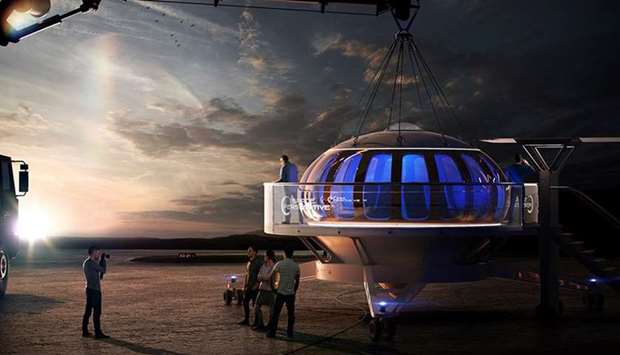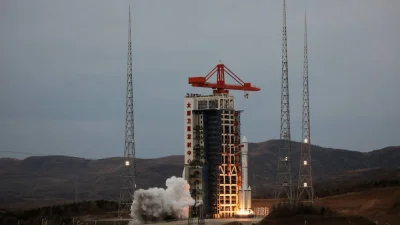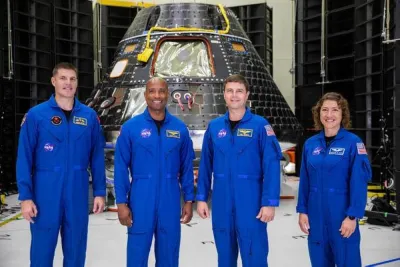A pair of self-described serial entrepreneurs, best-known for flying a KFC chicken sandwich into space and living two years sealed inside a biosphere, are attempting to start a new human spaceflight company that instead of launching rockets will lift civilian passengers into the sky tethered to a high-performance balloon.
Space Perspective, introduced during a video news conference last Thursday, aims to carry a capsule of eight passengers at a time, dangling from a 650-foot-tall balloon 100,000 feet above Earth. The balloon and capsule will gently ascend for about two hours at 12mph, floating along for another two hours as passengers enjoy refreshments and a view of the Earth below, and then descend back down at 12mph and splash down in either the Gulf of Mexico or the Atlantic Ocean.
The company will base its operations at Kennedy Space Center’s Launch and Landing Facility on Merritt Island and launch from there. It also will potentially launch from Cecil Spaceport in Jacksonville. Manufacturing facilities may later be based in Florida.
The goal is to make the flights as accessible and affordable to as many people as possible, one day possibly hosting weddings or corporate retreats. Co-founders Jane Poynter and Taber MacCallum, who are married, said they anticipate prices to be around $125,000 for a single ticket.
“That’s really what this is all about: Everybody should be able to see the Earth from space,” Poynter said. “We want them to really be able to experience what astronauts talk about, seeing the Earth in space in that inky blackness of the cosmos, looking down at the curvature of the Earth.”
But passenger flights are still at least a year away.
Hoping to perform its first test flight in early 2021, Space Perspective joins the ranks of burgeoning companies working to create an industry that can send paying passengers to the edges of space, generally thought to begin about 50 miles off Earth’s surface. Space Perspective’s balloon will reach about 20 miles.
SpaceX, Virgin Galactic and Blue Origin have been among the most high-profile companies to set their sights on flying regular people to space.
Poynter and Taber have successfully developed and test-driven other balloon crafts, at another company they founded in 2012 called World View Enterprises. That endeavour drew a lot of publicity when it hoisted Google executive Alan Eustace for the highest-altitude free-fall jump and when it flew a KFC chicken sandwich into the sky.
Since Poynter and MacCallum left World View, the company has focused on flying payloads instead of people.
“The balloon technology and putting people into space via a balloon has been done before so it’s clearly a proven technology. What has not been done, which I think is the challenge that they’re hoping to address, is the ability to do so at a sufficiently affordable and reliable and regular enough cadence,” said Dale Ketcham, vice president of government and external relations for Space Florida, the aerospace economic development agency of Florida.
Passengers will need very little training before taking a ride with Space Perspective, MacCallum said. During the flight, the interior of the capsule will be pressurised and temperature and humidity will be controlled. Onboard there will be a pilot, paired with another down on Earth who can also control the craft.
A new balloon, which will be filled with hydrogen as helium has become more scarce, will be used for each flight and materials from it upcycled. The capsule will be able to be reused on multiple missions.
Renderings of the spacecraft, to be named Spaceship Neptune, depict a large capsule with a circle of seats facing out to a row of windows. Poynter and MacCallum said a bar, bathroom and an unobstructed windowed dome at the top of the capsule will be integrated into the design.
It will also have room to fly research payloads and experiments that Poynter said will study climate change, the atmosphere and the origins of life in the universe.
The company has signed a Space Act Agreement with the National Aeronautics and Space Administration, which will provide access to test facilities, technical support during launches and weather data to plot the balloon’s ascent and splashdown. The balloon vehicle will be regulated as a spacecraft by the FAA.
Base Ventures CEO Kirby Harris, Space Perspective’s lead investor, will serve as a board member for the new company, and Nasa astronaut Jeff Hoffman will serve as senior technical adviser.
Poynter and MacCallum plan to be on one of the first test rides. The self-taught researchers over the years have cultivated a somewhat eccentric reputation in the space fandom.
One of their most successful undertakings was at Paragon Space Development Corp., a company they founded in 1993 that designed a spacesuit life-support system funded by a $1.4 million grant from Nasa in 2010 as part of the Commercial Crew Program that at the time was trying to foster public-private partnerships to develop new technologies. Neither of Nasa’s commercial crew partners, Boeing nor SpaceX, has used the spacesuit system, however, Nasa said.
At Paragon, they later started pursuing another objective, to become the first humans to fly past Mars, but without funding from Congress or a suitable spacecraft, they eventually abandoned the plan.
But Poynter and MacCallum’s celebrity originates from the two years and 20 minutes they spent living inside Biosphere II, a steel and glass, terrarium-like research facility that sprawled three acres of the Sonoran Desert in Arizona.
Part of a crew of eight men and women, Poynter and MacCallum studied the survivability of the space colony simulation, farming crops and raising animals, to evaluate if one day humans could live in similar self-sustained colonies on other planets.
The experiment, hoped to be a blueprint for colonising Mars and predicted by physicist Carl Hodges to potentially be “the most significant scientific project of all time,” was widely considered a failure, marred by the crew’s inability to create a liveable environment that prompted intervention from those on the outside running the experiment.
But Poynter said it served as the beginning for her and her husband’s journey to send people into space.
“We’ve been working on this concept for a long time,” Poynter said. “It goes all the way back to our days at Biosphere II.” —The Orlando Sentinel (Orlando, Florida)/TNS

CONCEPT: Space Perspective joins the ranks of burgeoning companies working to create an industry that can send paying passengers to the edges of space.


